The 2021 World Chess Championship (WCC) is currently taking place in Dubai, and we have had our first decisive game.
The defending champion is Magnus Carlsen, a 31 year old Norwegian, and he has been the World Chess Champion for the past 8 years.
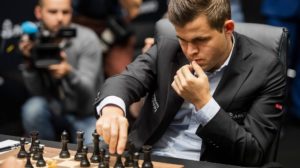
Carlsen became the Champion when he dethroned the Indian Former World Champion Viswanathan Anand, in 2013. Since then, Carlsen has defended his title against the automatic rematch versus Anand in 2014, in 2016 versus World No. 9 Russian Sergey Karjakin, in 2018 versus then World No. 2 Italian-born American Fabiano Caruana.
The current match is Carlsen defending his title versus World No. 5, Russian born jew Ian Nepomniachtchi. Since nobody can spell his last name, he goes by the nickname Nepo. As a curious aside, Nepo was also an excellent DOTA 2 player, although he gave that up for chess.
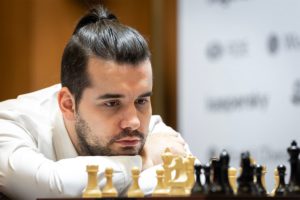
Chess is, to my knowledge, the originator of the Elo rating system, named after Hungarian mathematician Arpad Elo. This system takes into account playing strength, but is essentially an improved win-loss record. Beating someone of high strength gives more points than beating someone of low strength, and the same is true for losses in reverse.
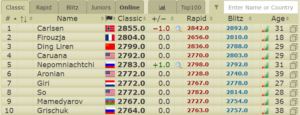
Above is the current, up to date Elo ratings for the top 10 players in the world, along with nationalities, taken from 2700chess. Carlsen, or anyone else, could be World Chess Champion without being the highest rated player, and he was approximately 100 Elo points higher than Anand when he was the challenger in 2013, and won the title.
Similarly, to become the challenger for the Championship, there is a complicated qualifying process that involves multiple tournaments, culminating in the Candidates Tournament, which Nepo won. You do not have to be the second highest rated player purely by Elo, although Elo rating is used in the qualification process.
As an aside, current world number 2 is Iranian child prodigy Alireza Firouzja, whom many consider to be a true talent on par with Carlsen. As you might imagine, Carlsen was himself a child prodigy throughout his early and late teenage years, becoming the highest rated player, but not champion, just after turning 20.
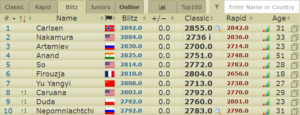
Above is blitz Elo ratings, showing Carlsen to be leagues ahead of the rest of the pack, with the exception of Hapa-American Hikaru Nakamura, who has retired from classical chess. If you have some time to waste, watching either of the two stream bullet or blitz chess is certainly quite impressive, especially if you play chess yourself.
There’s something otherworldly about how amazing at chess these people truly are. Carlsen, and pretty much every 2700+ player, is easily capable of playing more accurate bullet chess games (less than 1 minute to play the entire game), than I am rapid games (15 minute + 10 extra seconds per move), and I’m a 1700 player myself.
But we’re not talking about online bullet games. We’re talking about the World Chess Championship. The time control rules they are playing with are 2 hours for the first 40 moves, after which another hours is added to their clocks until move 60, and then 15 minutes is added to their clocks after that, and they play get an additional 30 seconds per move.
These time control rules are considered by most to be not needlessly long, but still long enough for extremely deep and accurate games of chess to be played, and that is exactly what happened today. While the first five games of the match were fairly uneventful draws, the sixth game was an extremely complicated, and extremely interesting game.
Great analysis of the game is presented below, by GM Robert Hess, IM Daniel Rensch, and GM Fabiano Caruana.
The game starts off hot, with Magnus Carlsen, with the white pieces, having a moderately sharp opening prepared for Nepo, who has black, in the Catalan, a well known opening. Sharp basically means “it’s easy to make some wrong moves and lose,” in this context, where there are other positions in chess where it’s easier to make reasonable moves that don’t lose the game.
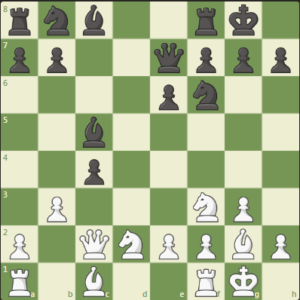
This is the position on move 10, and this is already a new position that has never been reached before in any recorded classical chess game. This is important, because chess game start from the same position, and there are only so many reasonable moves to play in any given position. At the highest level of chess, often these players can play an extraordinary amount of “theory,” and have much of the excitement of the game already be over before either player is given a new position.
Instead, we have the above, and while Carlsen no doubt had prepared this early opening novelty, Nepo handled it extremely well, and equalized with black fairly easily. While the game was “new” from move 9, typically for a few moves after both players still know many of the fundamental ideas in the position, but this fades rapidly as they get to less and less familiar positions.
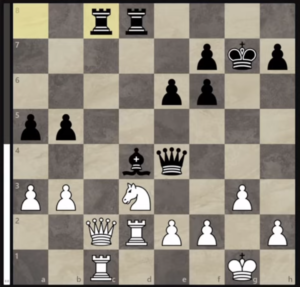
24. Rac8
We came to a pivotal moment of the game as early as move 24, shown above. Nepo decided to play Rac8, giving Carlsen the opportunity to exchange his queen for two rooks. This move, while not necessarily a sacrifice, massively imbalances the game should Carlsen accept.
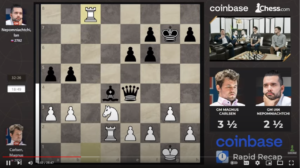
Move 26. Rxc8. Previously 25. Qxc8 Rxc8
Which he did, giving us the above, extremely interesting position.
It is so interesting in part because there are a few clear imbalances in the position. Black has a bishop versus the white knight, and the pawn structure is different in numerous ways, especially in front of Nepo’s king. But most importantly, white does not have a queen, instead having two rooks for the queen, and vice versa for black.
At the side of the screen you can see the engine evaluation. The engine says that this position is equal, but that’s far from the whole story. Imbalanced positions, especially with lots of material still on the board, are extremely difficult for even the strongest players to play accurately. Throughout the rest of this game we see a few inaccuracies and mistakes from both players in such a complicated position.
Before we go further, I need to show a very clear example of why engine evaluation is somewhat overrated as a tool for guessing who has an advantage, or who is going to win. Endgames such as these are extremely difficult to play, and having a computer pointing out flaws in some players can diminish the appreciation for the skill and talent displayed over the board.
I’ve started the above video from a certain part where they go through some very complicated lines that could have been played earlier in the endgame. Remember, Hess and Caruana are GMs, with Caruana being the current World No. 4 player, and even they had an extremely difficult time understanding why the engine was saying that White had an extremely large non-winning advantage in a certain line.
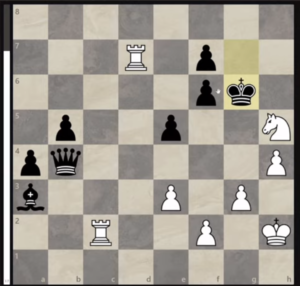
This position was not reached in the game.
The above position is a sideline that was not played in the game. Can you guess what the engine wants you to play in the above position?
The computer wants to sacrifice the knight in exchange for a very non-obvious mating mating attack on the king, without many forcing moves, by playing Rc6!. This is something that was almost certainly not even considered by either player, and for good reason. And in the above position, if you play anything other than the hard to see Rc6, the engine calls you a retard and tells you that you blundered your entire advantage.
My point is that this is incredibly difficult stuff, and you need to take that into account if you see some analysis that is simply “engine said White had advantage if *playsCompletelyNonObviousMove, so hurr durr World Champion Carlsen totally missed that what a dummy.” Missing these types of moves is not a real mistake, no human should be expected to make those moves.
And again, even the extremely strong players doing the analysis struggled to figure out why the engine liked white’s position so much, and they had the advantage of seeing, through the eval bar, that white must have some winning idea.
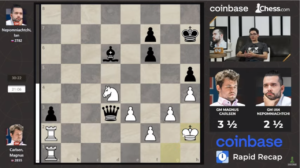
Move 52. Kh2
Getting back to the game that was actually played, according to Caruana’s analysis, there was a fairly human error made by Nepo on move 52. In the above picture, Nepo, with black, fell into a minor trap from Carlsen when Nepo played Qe4. Caruana’s analysis showed he should have played something like Kg6, and waited to see what white plays next.
The game continued with Nepo taking the h pawn with check, but this allowed Carlsen to get an endgame that was technically drawn, but in which he had serious practical chances to win.
What follows was a long maneuvering stage where Carlsen started organizing his pieces correctly to put maximum pressure against black’s position. This culminated in a fascinating position on Move 79.
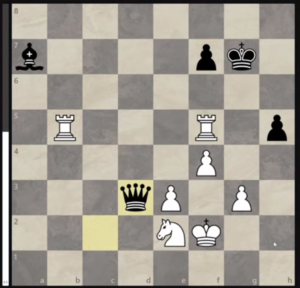
It’s white to move, and it looks like black is going to win the pawn on e3, with a serious advantage. If white plays something like Rfe5, this doesn’t actually defend the pawn, since Bxe3+ Rxe3, and blacks queen now captures the rook on b5. The same is true if white tries defending with the other rook.
If it was black to move he could play Qxe5, and now if the king moves away from the knight, we can at least win the knight for free. If the king tries to defend the knight from f1, then Qf2 is checkmate. So we would have to calculate if after Qf2+ Kd2, the king is safe on d2. But we also need to calculate what happens if the queen stays on e3, and black exploits the pinned knight by playing Bd4, and making serious mate threats, since he can play the bishop to c3 in some lines.
There are many other moves that may be even superior to the above. I’m trying to show how complicated these kinds of positions are, and how easy it is for even non-terrible players to blunder horribly.
But white has a way to get a serious advantage. Can you spot the move?
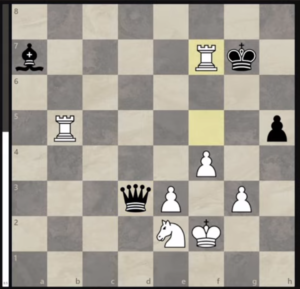
80. Rxf7+!
Carlsen sacrificed his rook to then check with the other rook and take blacks dark squared bishop. This technically lost 1 point of material, but it relieved the pressure on whites position.
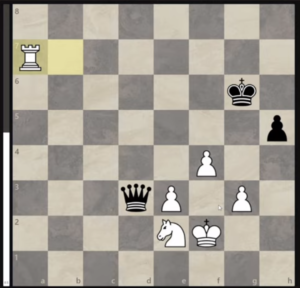
82. Rxa7. The culmination of the tactic.
White has far from a winning position, but does enjoy a clear advantage. Carlsen is known as being an extremely accurate and capable endgame player, who presses small endgame advantages and eventually cracks even the strongest players in the world. Because of this, many were expecting a Carlsen victory here, even if the position might still be a draw with perfect engine play.
The main problem for black is that it’s extremely hard to attack white in the above position, since he doesn’t have any checks with his queen, or really many resources in this position. The pawn structure in front of Carlsen’s king, combined with his knight, take away checks from blacks queen.
Beyond that, it was getting late in Dubai, and both players had been calculating extremely hard for many hours at this point. Physical exhaustion was setting in.
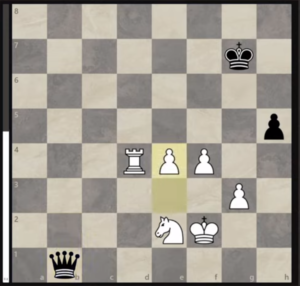
Move 110. e4
Carlsen probed Nepo’s position consistently, hoping for a blunder. When none was forthcoming, he prepared and then executed a pawn push. On move 110, Carlsen pushed his e pawn forward one square, indicating that this game was going to grind on even longer, and Carlsen was going to be playing for a win.
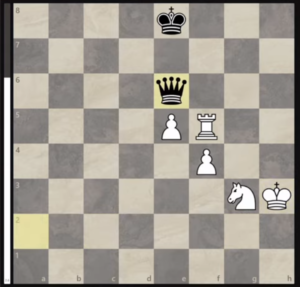
Move 130. Qe6. A natural move that is a fatal error.
Carlsen got two connected passed pawns, and slowly made progress pushing them up the board. For those that don’t know, when a pawn goes to the end of the board it turns into a queen, which is in almost every case a winning advantage.
Nepo’s 130th move, Qe6, looks extremely natural. He pins the rook to the king, and blocks the pawns. He also gives himself the option to check Carlsen’s king on the h file. Until this move has Nepo had defended resiliently, but in such positions the defending player must defend absolutely perfectly for tens of moves in a row. This causes such positions to be extremely difficult to hold in practice, especially after hours of play.
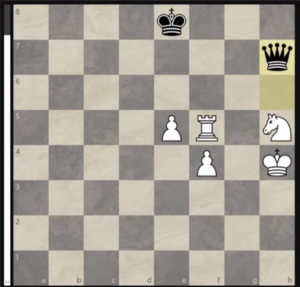
After 132. Qh7
Just a few moves later, move 133, we get to the above position. Carlsen’s rook is attacked by the queen, and he has the long term goal of pushing the pawns forward. Many moves don’t make progress here. Can you guess what Carlsen played?
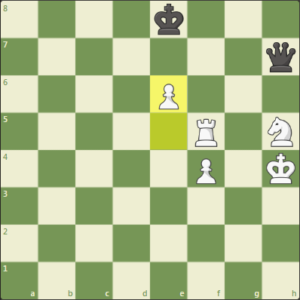
133. e6!
The rook cannot be taken, because Ng7+ forks the king and the queen. Just a move later we came to another similar tactic.
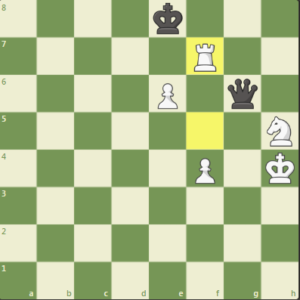
Position after 134. Re7.
Nepo had brought his queen in on move 133. And after 134. Rf7 by Carlsen, he played Kd8. Why did he not play Qxe6, removing the very dangerous pawn? Try to calculate the line to the end, it’s a bit more complicated than you may think.
Answer: It simplifies to a winning King and Pawn ending for Carlsen.
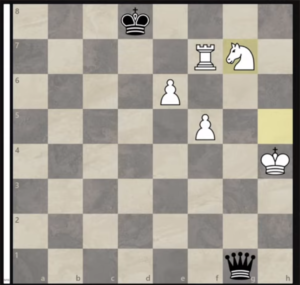
Position after 136. Ng7. Black resigned.
Nepo resigned in the above position, on move 136. His problem is that he simply can’t stop Carlsen from pushing his e pawn to e7, and then queening on e8. He can check the king, but the king will eventually find shelter, perhaps even all the way on g8.
This was a fascinating game of chess. A relatively non-theoretical and yet sharp opening, sharp tactics in unclear positions, imbalances between sides, and then an educational endgame played by the world champion. And of course, the stakes were the world championship.
With this win, Carlsen moves up one game on Nepo, with 8 games remaining in their match. It’s an large advantage, but far from insurmountable. We’ll cover other decisive games, and write about the result of the match after it is over.

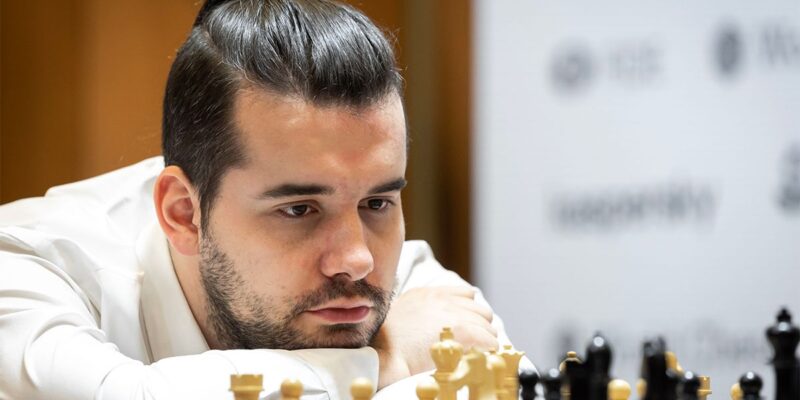














[…] is simply how hard the challenger, Ian Nepomniachtchi has choked. The first game he lost, covered here, was a grueling affair, where he played extremely well, and simply lost to a dominant champion. The […]